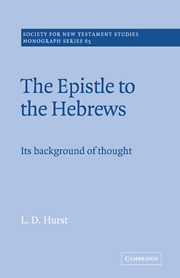3 - Other non-Christian backgrounds
Published online by Cambridge University Press: 20 November 2009
Summary
Pre-Christian gnosticism
With the rise of interest this century in gnosticism and its possible role in the formation of the NT, it was inevitable that a writing which had already been interpreted in terms of Philo's de-emphasis upon the material realm should be placed into a gnostic framework. Already in 1922 Scott spoke of Hebrews as “gnosis,” while others, without using the term, paved the way for a “gnostic” interpretation of the epistle. The first thoroughgoing exposition was that of E. Käsemann in 1939. While acknowledging Jewish and Alexandrian elements, Käsemann saw the main influence behind Hebrews as a pre-Christian gnosticism which, centering on a myth of the redeemed redeemer, conceived of salvation as a journey from the enslaving realm of the material to the heavenly realm of light. Käsemann thus differed from Michel, for whom Hebrews was basically apocalyptic. As with Phil. 2, the Son in Hebrews was now seen to be the gnostic anthropos or Urmensch, while the “enlightened” are those who advance toward the same stage of “perfection” in knowledge which the Son has already achieved. He also felt that underlying Heb. 7 was a gnostic tradition of Melchizedek as the incarnation of the Urmensch. Käsemann relied upon Mandaean, Manichaean, rabbinic and Hermetic literature, the Testaments, the Acts of Thomas, Pistis Sophia, III Enoch and the Odes of Solomon. These texts, he felt, reflect traditions which antedate Auctor and Philo.
- Type
- Chapter
- Information
- The Epistle to the HebrewsIts Background of Thought, pp. 67 - 86Publisher: Cambridge University PressPrint publication year: 1990



